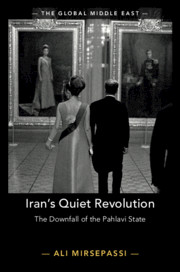Book contents
- Iran’s Quiet Revolution
- The Global Middle East
- Iran’s Quiet Revolution
- Copyright page
- Contents
- Acknowledgments
- Note on Transliteration
- Introduction
- 1 The Allure of the “Anti-modern”
- 2 De-politicizing Westoxification:
- 3 Ehsan Naraghi:
- 4 Iranian Cinema’s “Quiet Revolution” (1960s–1970s)
- 5 A Garden between Two Streets:
- 6 The Shah as a “Modern Mystic”?
- 7 The Imaginary Invention of a Nation:
- 8 An Elective Affinity:
- Bibliography
- Index
5 - A Garden between Two Streets:
“Bearing Witness” to “Iranian Modernities”
Published online by Cambridge University Press: 23 August 2019
- Iran’s Quiet Revolution
- The Global Middle East
- Iran’s Quiet Revolution
- Copyright page
- Contents
- Acknowledgments
- Note on Transliteration
- Introduction
- 1 The Allure of the “Anti-modern”
- 2 De-politicizing Westoxification:
- 3 Ehsan Naraghi:
- 4 Iranian Cinema’s “Quiet Revolution” (1960s–1970s)
- 5 A Garden between Two Streets:
- 6 The Shah as a “Modern Mystic”?
- 7 The Imaginary Invention of a Nation:
- 8 An Elective Affinity:
- Bibliography
- Index
Summary
The soaring oil revenues produced the conditions, good or bad, and offered the chance for Iranian culture to own one of the most precious museums in the world, with collections of rare twentieth-century art. These collections could seldom be seen even at the most prestigious European museums. In the meantime, in the Museum of Ancient Iran, they stocked dead and old Iranian objects that no one ever paid much attention to.1
- Type
- Chapter
- Information
- Iran's Quiet RevolutionThe Downfall of the Pahlavi State, pp. 133 - 151Publisher: Cambridge University PressPrint publication year: 2019

